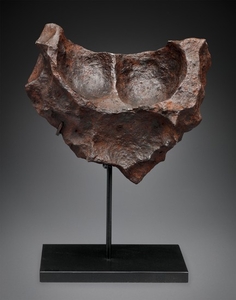Deep Impact: Martian, Lunar and other Rare Meteorites
Draped in a milk chocolate-hued patina with variegated ochre accents, two adjacent scoops are separated by a thin vertical ridge and cradled by a thicker horizontal. These basins were most likely the result of cavities that grew after iron sulfide (troilite) inclusions weathered out of the meteorite as it sat underground in the Kalahari. A ridge on the right perimeter is flat — the result of having split along a crystalline plane. Accompanied by a custom armature.
121 x 163 x 79 mm. (4¾ x 6½ x 3 in.) and 4,217 g. (9¼ lbs)
A 4.5 billion-year-old abstract form, shaped by forces both extraterrestrial and terrestrial, and originating from the asteroid belt. Like most iron meteorites, Gibeon meteorites originated 4.5 billion years ago from the molten core of an asteroid located between Mars and Jupiter whose shattered remains are part of the asteroid belt. An impact event ejected what was to become the Gibeon mass into interplanetary space, and Gibeon meteorites are the bounty that occurred thousands of years ago when the wandering iron mass slammed into Earth’s atmosphere before exploding and raining down in what is now the Kalahari Desert in Namibia. In previous generations, indigenous tribesmen recovered the smallest meteorite shards and fashioned them into spear points and other tools. This specimen was recovered with the aid of a metal detector. Its final shape being the product of a fortuitous combination of variables including its composition, the soil chemistry in which it landed, its orientation in the ground and the amount of groundwater to which it was exposed — all of which slowly reshaped this mass as it sat near the Earth’s surface as the seasons turned over thousands of years. In effect, this meteorite was hewn by monumental forces encountered in space, frictional heating as it plunged through Earth’s atmosphere as well as the effects of Earth’s elements. While the vast majority of iron meteorites are prosaically shaped, that is not the case in regard to this engaging 4.5-billion-year-old otherworldly form, a tabletop sculpture from outer space.
Christie's would like to thank Dr. Alan E. Rubin at the Institute of Geophysics and Planetary Physics, University of California, Los Angeles for his assistance in preparing this catalog note.
View it on
Estimate
Time
Auction House
Draped in a milk chocolate-hued patina with variegated ochre accents, two adjacent scoops are separated by a thin vertical ridge and cradled by a thicker horizontal. These basins were most likely the result of cavities that grew after iron sulfide (troilite) inclusions weathered out of the meteorite as it sat underground in the Kalahari. A ridge on the right perimeter is flat — the result of having split along a crystalline plane. Accompanied by a custom armature.
121 x 163 x 79 mm. (4¾ x 6½ x 3 in.) and 4,217 g. (9¼ lbs)
A 4.5 billion-year-old abstract form, shaped by forces both extraterrestrial and terrestrial, and originating from the asteroid belt. Like most iron meteorites, Gibeon meteorites originated 4.5 billion years ago from the molten core of an asteroid located between Mars and Jupiter whose shattered remains are part of the asteroid belt. An impact event ejected what was to become the Gibeon mass into interplanetary space, and Gibeon meteorites are the bounty that occurred thousands of years ago when the wandering iron mass slammed into Earth’s atmosphere before exploding and raining down in what is now the Kalahari Desert in Namibia. In previous generations, indigenous tribesmen recovered the smallest meteorite shards and fashioned them into spear points and other tools. This specimen was recovered with the aid of a metal detector. Its final shape being the product of a fortuitous combination of variables including its composition, the soil chemistry in which it landed, its orientation in the ground and the amount of groundwater to which it was exposed — all of which slowly reshaped this mass as it sat near the Earth’s surface as the seasons turned over thousands of years. In effect, this meteorite was hewn by monumental forces encountered in space, frictional heating as it plunged through Earth’s atmosphere as well as the effects of Earth’s elements. While the vast majority of iron meteorites are prosaically shaped, that is not the case in regard to this engaging 4.5-billion-year-old otherworldly form, a tabletop sculpture from outer space.
Christie's would like to thank Dr. Alan E. Rubin at the Institute of Geophysics and Planetary Physics, University of California, Los Angeles for his assistance in preparing this catalog note.



